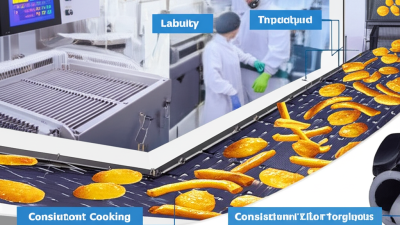Unlocking Efficiency: How Steam Retort Machines Enhance Food Safety with 99.99% Pathogen Elimination
Table of Contents
- Understanding the Science Behind Steam Retort Technology in Food Processing
- Key Benefits of Steam Retorts: Achieving 99.99% Pathogen Elimination Efficiently
- Comparative Analysis: Steam Retorts vs. Traditional Canning Methods
- Industry Statistics: Impact of Steam Retort Machines on Food Safety Standards
- Optimizing Food Shelf Life: The Role of Steam Retorts in Preservation
- Implementing Steam Retort Systems: Best Practices for Food Manufacturers
- FAQS
- Conclusion
- Related Posts
In our ongoing efforts to keep food safe and top quality, embracing new tech really makes a difference. One standout innovation is the Steam Retort Machine — it’s pretty much changing the game when it comes to processing and preserving food. Dr. Emily Hart from SafePreserve Technologies, an industry expert, highlights just how important this equipment is, saying, “The Steam Retort Machine is key for hitting those super high standards of pathogen elimination—up to 99.99% — which is vital for protecting consumers and public health.”
So, how does it work? Well, it uses high-pressure steam to heat up and treat the food, effectively killing off germs and bacteria that could cause food poisoning. As more people look for safe, ready-to-eat meals, understanding the ins and outs of Steam Retort Machines becomes even more essential. In this article, I want to dive into how this technology not only boosts food safety but also makes food processing more efficient overall.
For food companies, investing in a Steam Retort Machine can really pay off. It helps reduce contamination risks, extends shelf life, and makes sure they’re meeting all the rules — all while keeping costs in check. As we dig deeper, I’ll share some practical insights on how to get started with this tech and why it’s such a game-changer for the food industry.

Understanding the Science Behind Steam Retort Technology in Food Processing
Steam retort technology has revolutionized food processing by ensuring optimal safety and quality through advanced pathogen elimination techniques. This method employs precisely controlled steam and pressure environments that allow for effective heat penetration into various food products, ultimately leading to a remarkable 99.99% pathogen reduction. Studies have shown that understanding the intricate dynamics of heat distribution within retorts is essential. For instance, research on the geometry of semi-rigid plastic trays has demonstrated how different shapes can significantly influence heat penetration, highlighting the importance of continuous innovation in retort design to enhance food safety further.
In the context of energy efficiency, modern steam generators and retorts are equipped with intelligent controls and improved ancillary equipment that not only conserve energy but also maintain product integrity during processing. As food preservation remains a critical concern in the global landscape, this advancements in retort technology contribute to sustainable practices by minimizing waste and enhancing the overall quality of processed foods. The integration of new methods, such as gentle motion retorts, is also emerging, particularly in specialized applications like military food development, showcasing the versatility of steam retort systems in meeting diverse food safety needs.
Key Benefits of Steam Retorts: Achieving 99.99% Pathogen Elimination Efficiently
Steam retort machines have revolutionized food processing by enabling efficiency and ensuring safety through an impressive 99.99% pathogen elimination rate. According to industry reports, this high level of precision in pathogen reduction is crucial in addressing foodborne illnesses, which affect millions worldwide each year. The effectiveness of steam retorts not only meets regulatory standards but often exceeds them, positioning food producers at the forefront of safety innovation.
Additionally, steam retorts enhance operational efficiency, with the ability to process large volumes of food in a shorter timeframe. Research indicates that manufacturers using modern steam retort systems can reduce energy consumption by up to 30%, resulting in substantial cost savings. This translates into benefits not only for producers but also for consumers, who can enjoy safer products while manufacturers boost their production capabilities.
**Tips:** To maximize the efficacy of steam retorts, ensure regular maintenance and calibration of equipment, as this can further enhance pathogen elimination.Moreover, consider investing in training for staff on best practices during the operation of these machines, as proper handling can significantly impact food safety outcomes.
Comparative Analysis: Steam Retorts vs. Traditional Canning Methods
Steam retort machines represent a significant advancement over traditional canning methods when it comes to ensuring food safety. Unlike conventional techniques that primarily rely on heat application, steam retorts utilize pressurized steam to achieve more uniform heat distribution. This innovative technology not only enhances the efficiency of the sterilization process but also guarantees a remarkable
99.99% elimination of pathogenic microorganisms, thereby addressing crucial food safety concerns.
Shandong Kexinde Machinery Technology Co., Ltd. is at the forefront of this transformation in the food industry. As a dedicated manufacturer, the company specializes in the design and production of advanced food machinery, including steam retort systems. These machines not only meet stringent safety standards but also offer
flexibility and reliability, catering to the diverse needs of food, beverage, and healthcare product manufacturers. By integrating steam retort technology, companies can ensure longer shelf life and improved quality of their products, setting a new benchmark in food safety and efficiency.
Industry Statistics: Impact of Steam Retort Machines on Food Safety Standards
The increasing emphasis on food safety has driven innovations such as steam retort machines, which have proven pivotal in the elimination of pathogens. Reports highlight that these machines are capable of achieving a 99.99% pathogen elimination rate, crucial for meeting heightened food safety standards. In the European market, the demand for advanced food processing technologies is underscored by the projection that the insect protein market will reach USD 3422.72 million by 2034, growing at a staggering CAGR of 30.5%. This growth reflects the industry's shift towards sustainable protein sources, where safety and efficiency play vital roles.
Moreover, as the global digestive health products market is set to expand to USD 124.4 billion by 2034 at an 8.5% CAGR, the integration of steam retorts in processing lines continues to be a focal point for manufacturers. Such technology not only enhances the safety and shelf life of food products but also aligns with the industry's broader trends towards health and wellness. The adoption of automated operations in processing facilities, as exemplified by high-speed filling and retort sterilization practices, is indicative of a transformative shift aimed at both efficiency and compliance with rigorous food safety regulations.

Optimizing Food Shelf Life: The Role of Steam Retorts in Preservation
The advancement of steam retort technology has revolutionized food preservation, playing a pivotal role in extending the shelf life of various products. A study by the Food and Drug Administration (FDA) indicated that proper usage of steam retorts can reduce spoilage and enhance safety by achieving a remarkable 99.99% pathogen elimination rate. This impressive figure not only ensures the safety of food products but also minimizes the economic losses that arise from spoilage.
Furthermore, steam retort machines operate by utilizing high-pressure steam to sterilize food in sealed containers. According to a report from the Food Processing Technology Association, the application of steam retorts can significantly prolong the shelf life of canned goods and ready-to-eat meals, providing consumers with healthier and safer options. By maintaining optimal temperature and pressure conditions, steam retorts effectively destroy harmful bacteria and preserve nutritional quality, contributing to a more sustainable food supply chain. As demand for long-lasting and safe food products continues to rise, the adoption of steam retort technology appears not only beneficial but essential for the food industry.
Unlocking Efficiency: Pathogen Elimination Rates with Steam Retorts
Implementing Steam Retort Systems: Best Practices for Food Manufacturers
Implementing steam retort systems has become a cornerstone for food manufacturers aiming to enhance food safety and shelf life. These systems use high-temperature steam to destroy harmful pathogens, achieving elimination rates of up to 99.99%. According to the International Journal of Food Microbiology, effective thermal processing is essential in reducing foodborne illnesses, and steam retorts provide uniform and consistent heat distribution, crucial for ensuring that all food products meet safety standards.

Best practices in deploying steam retort machines involve strict adherence to established processing times and temperatures calibrated to the specific type of food being processed. The Food and Drug Administration (FDA) has outlined protocols that suggest maintaining temperatures above 121°C (250°F) for adequate pathogen control. Moreover, integrating automated monitoring systems can help manufacturers track parameters such as temperature and pressure in real-time, ensuring compliance and enhancing operational efficiency. By leveraging these advanced practices, food manufacturers can not only safeguard public health but also bolster consumer confidence in their products.
FAQS
: Steam retort technology is a method used in food processing that employs controlled steam and pressure environments to effectively eliminate pathogens and ensure food safety and quality.
Steam retort technology achieves a remarkable 99.99% reduction in pathogens, ensuring enhanced safety and quality of food products.
Steam retort technology significantly reduces spoilage and enhances the shelf life of various food products by sterilizing food in sealed containers using high-pressure steam.
Best practices include adhering to established processing times and temperatures specific to the food type, maintaining temperatures above 121°C (250°F), and integrating automated monitoring systems for real-time tracking.
Energy efficiency is vital as it not only conserves energy but also maintains product integrity during processing, contributing to sustainable practices in the food industry.
Research indicates that the shape of semi-rigid plastic trays can significantly influence heat penetration, highlighting the need for continuous innovation in retort design.
Gentle motion retorts are a newer method within steam retorting technology, particularly emerging in specialized applications like military food development, showcasing the versatility of retort systems.
The FDA recommends maintaining processing temperatures above 121°C (250°F) to ensure adequate pathogen control during steam retort processing.
By minimizing waste and enhancing the overall quality of processed foods, steam retorts help create a more sustainable food supply chain while addressing the demand for safer food options.
By leveraging advanced practices and ensuring compliance with food safety standards, steam retorts help food manufacturers safeguard public health, thereby increasing consumer trust in their products.
Conclusion
The article "Unlocking Efficiency: How Steam Retort Machines Enhance Food Safety with 99.99% Pathogen Elimination" delves into the revolutionary advancements brought by steam retort technology in food processing. This method ensures an impressive 99.99% elimination of pathogens, significantly bolstering food safety standards. By comparing steam retorts with traditional canning methods, the article highlights the superior efficiency and effectiveness of steam retort machines in achieving food preservation while extending shelf life.
Furthermore, the discussion on industry statistics emphasizes the profound impact these machines have on maintaining high food safety standards across various sectors, including food, beverage, and healthcare products. For food manufacturers, implementing steam retort systems involves best practices that maximize operational efficiency and product safety, underscoring the importance of investing in advanced technology for future growth. Shandong Kexinde Machinery Technology Co., Ltd. stands as a leader in this field, offering state-of-the-art steam retort machines designed to meet the evolving demands of the industry.
Related Posts
-

Maximize Your Investment with Exceptional After Sales Support for Best Crisp Chips Making Machine
-

Unmatched Onion Ring Breading Machines from Leading Chinese Manufacturers for Global Excellence
-

Advantages of Conveyor Belt Frying Machines for Efficient Food Processing
-

Step-by-Step Guide to Selecting the Best Potato Chips Fryer Equipment for Your Business
-

Innovative Basket Cleaning Machine Solutions Showcased at 2025 Canton Fair in China
-

How to Optimize Your Chicken Nuggets Frying Machine for Maximum Efficiency

